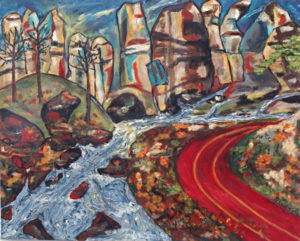 Into the John Day Fossil Beds
Into the John Day Fossil Beds
Dig It
Summer is a time to inspire youth and renew your own craving for adventure. For mystery lovers, it does not get any better than going on a big dig! Paleontology and archaeology sites around the world present some of the best ways to satisfy curious minds. So put on that pith helmet and take off for the experience of your life.
You are never too old. Last week I drove to Fossil, Oregon with my eldest son. We went behind the High School with shovels and pails and dug for treasures, finding 30 million year plant fossils. A nearby trail through the John Day National Monument pointed out environmental changes over a 50 million year period. The above painting was my way of documenting the change.
Imagine the excitement of finding an dinosaur bone sticking out of the earth in Texas, Montana or even China? You will immediately be transported back 65 million years to when these colossal creatures walked the earth. If you participate in the painstaking job of exposing these heavy fossilized bones, you will have plenty of time to wonder how huge creatures managed to forage for food and raise their young. You might question why they went extinct and which mammals, birds or amphibians today are distant relatives. Fossil digs take perseverance and careful adherence to strict research rules often in uncomfortable environments. But it is fun to be part of a team which is why so many families sign up to go on volunteer expeditions.
Museums are great places to go to become inspired. The Fort Worth Museum of Science and History has an outdoor dino-pit so children can get the feel of a dig. The Science Museum of Minnesota and the Oregon Museum of Science and Industry, installed labs where visitors can watch scientists work uncovering and assembling fossils. There may even have a fossil for you to excavate. In front of the world famous Natural History Museum of Los Angeles County, the La Brea Tar Pits bubbles where specimens were trapped thousands of years ago. the museum has a display of many of their discoveries.
If you don’t have the time to go on a dig, you certainly can live vicariously through. videos and movies. Dr. Stefano Piccini, inspired as a youngster, went on to study Geological and Paleontological Science from the University of Bologna. He now travels the world uncovering fossil and mineral deposits and employing the latest techniques for restoration and display. He shares his excitement with the public through television presentations, lectures and installations of geological and paleontological specimens in museums and private collections.
What gives a child the impetus to want a career in geology or paleontology? It often starts with a gift by a relative. An educational dinosaur dig toy, a visit to a museum, a book or exposure to a fossilized tooth may be enough to ignite the spark to ignite curiosity. Small beginnings can lead to large discoveries. It worked for me. As a child I visited museums in Philadelphia with my parents. The Franklin Institute, with its hands-on approach to learning, and the Natural History Museum inspired me to pursue a career as a museum executive.
It is a good time to have a job as a paleontologist. New imaging devices and global warming have exposed an unprecedented number of fossils. According the Bureau of Labor Statistics, geoscientists, which include paleontologists, earn an average of $106,390 annually. Though universities and museums are experiencing difficulty getting funding for research projects, industry jobs are expanding. Infrastructure laws for highways, gas and oil drilling and pipelines, electric and phone lines have become more restrictive when it comes to collecting and preserving fossils. This has led to the expanding field of environmental consulting.
But industry is not the only place vertebrate paleontologists are found. It may surprise you to know that medical and dental universities use them because of their knowledge at the cellular level. Science journalism, artists and special effects workers are also in demand as are governmental jobs with the Bureau of Land Management, The National Park and Monuments, and the National Forest Service..
Whether seeking a career or a volunteer position it is key opening to take off blinders and open yourself to previously unimagined opportunities. The world is a intriguing planet to explore above and below the surface.
